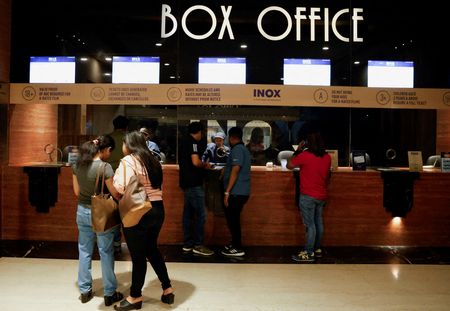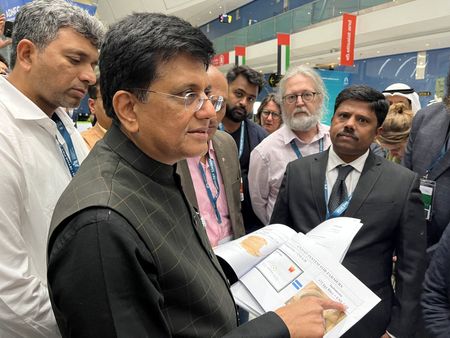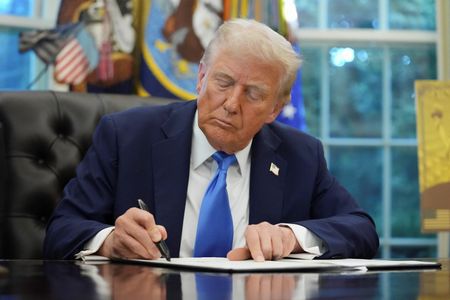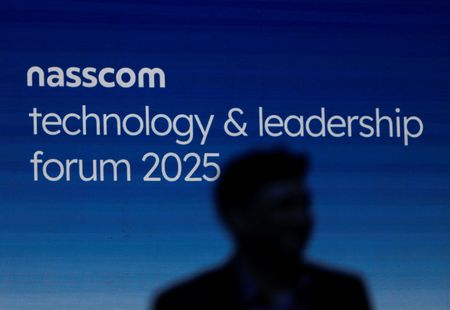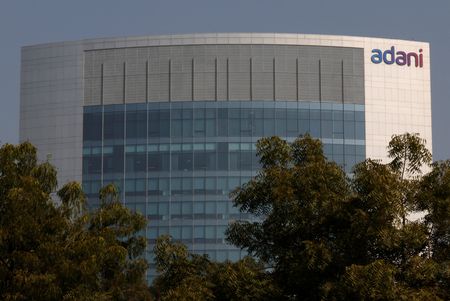By Haripriya Suresh, Saurabh Sharma and Rishika Sadam
BENGALURU/NEW DELHI/HYDERABAD (Reuters) -India’s film industry, which earns roughly 40% of its overseas revenue from the United States, sounded the alarm this week about higher costs after President Donald Trump threatened a tariff of 100% on all movies produced beyond American soil.
Film makers, producers and distributors in one of the world’s largest film industries by output struggled to weigh the likely impact of such a tariff as Trump provided scant details, stirring more questions than answers.
“The real question is how the term ‘foreign produced’ will be defined, and until that’s clear, it’s hard to say anything,” said film maker Anubhav Sinha, known for his Netflix streaming series, “IC 814: The Kandahar Hijack”.
“It’s not yet clear whether services like post-production will be affected.”
India’s film industry employs 272,000 people, with overseas box office takings of about 20 billion rupees ($237 million) in fiscal 2024, or a tenth of total earnings, Deloitte and studio grouping the Motion Picture Association said in a report.
Key Hollywood films with India scenes are Oscar-winners such as the rags-to-riches tale “Slumdog Millionaire”, and the Osama bin Laden manhunt thriller, “Zero Dark Thirty”, along with rom-com “Eat, Pray Love”, and Batman outing “The Dark Knight Rises”.
In the absence of details on the planned levy, film producers worry it could double the cost of exporting their films to the United States, where people of Indian descent are estimated to number 5.2 million.
“The United States is one of the most important overseas markets for Indian cinema, largely due to the substantial diaspora,” said producer Madhu Bhojwani, reponsible for hits such as “Airlift”, on workers evacuated from Kuwait during the Gulf War.
“Any increase in ticket prices resulting from these tariffs would directly affect audience turnout, compounding the challenges posed by evolving consumer behaviour and broader industry headwinds.”
The cost-effective South Asian nation has also grown in stature as Hollywood’s preferred hub for on-ground production and post-production services, especially in visual effects, since it offers a skilled talent pool.
“Almost 10 to 15 (foreign) movies are shot in India every year, and our movie industry will be impacted very badly,” said film trade analyst Komal Nahta.
LIKELY HIT TO REVENUE
Prominent Indian actor and producer Prakash Raj called Trump’s move “tariff terrorism”.
If the tariff covers post-production services, the consequences will be bigger, added Bhojwani, the co-founder of Emmay Entertainment and Motion Pictures.
“We can expect a potential decline in outsourced work from U.S. studios to Indian vendors, which could have notable implications for the Indian media services sector,” she said.
“If revenue from the U.S. drops, it could affect budget planning and profitability for Indian production houses,” said Pradeep Dwivedi, chief executive of Eros International Media.
“Big-budget films counting on overseas revenue could be restructured or scaled back.”
The move will also hurt smaller releases in the United States.
“Even a 30% drop in revenue for such mid-scale movies would be a significant dent,” said Raj Kandukuri, producer of a well-regarded film, “Pelli Choopulu”, in India’s southern language of Telugu.
“There are a sizeable number of students in the United States who watch movies, they will not spend high on ticket prices.”
The planned levy might also drive a broader shift to digital platforms.
“U.S. distributors might be less inclined to pick up Indian titles due to the increased cost,” Dwivedi said.
“This could result in fewer screens, smaller releases, and a shift toward digital platforms instead of theatrical. The tariff would likely accelerate a move toward direct-to-digital releases on platforms like ErosNow, Netflix, Amazon Prime, and Hulu.”
($1=84.2560 rupees)
(Reporting by Haripriya Suresh in Bengaluru, Saurabh Sharma in New Delhi, and Rishika Sadam in Hyderabad; Editing by Dhanya Skariachan and Clarence Fernandez)

